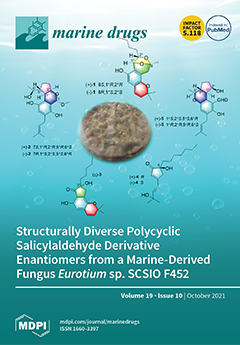Turbo cornutus, the horned turban sea snail, is found along the intertidal and basaltic shorelines of Jeju Island, Korea.
T. cornutus feeds on seaweeds (e.g.,
Undaria sp., and
Ecklonia sp.) composed of diverse antioxidants. This study identified potential antioxidant properties from
[...] Read more.
Turbo cornutus, the horned turban sea snail, is found along the intertidal and basaltic shorelines of Jeju Island, Korea.
T. cornutus feeds on seaweeds (e.g.,
Undaria sp., and
Ecklonia sp.) composed of diverse antioxidants. This study identified potential antioxidant properties from
T. cornutus viscera tissues. Diverse extracts were evaluated for their hydrogen peroxide (H
2O
2) scavenging activities.
T. cornutus viscera protamex-assisted extracts (TVP) were purified by gel filtration chromatography (GFC), and potential antioxidant properties were analyzed for their amino acid sequences and its peroxidase inhibition effects by in silico molecular docking and in vitro analysis. According to the results,
T. cornutus viscera tissues are composed of many protein contents with each over 50%. Among the extracts, TVP possessed the highest H
2O
2 scavenging activity. In addition, TVP-GFC-3 significantly decreased intracellular reactive oxygen species (ROS) levels and increased cell viability in H
2O
2-treated HepG2 cells without cytotoxicity. TVP-GFC-3 comprises nine low molecular bioactive peptides (ELR, VGPQ, TDY, ALPHA, PAH, VDY, WSDK, VFSP, and FAPQY). Notably, the peptides dock to the active site of the myeloperoxidase (MPO), especially TDY and FAPQY showed the MPO inhibition effects with IC
50 values of 646.0 ± 45.0 µM and 57.1 ± 17.7 µM, respectively. Altogether, our findings demonstrated that
T. cornutus viscera have potential antioxidant properties that can be used as high value-added ingredients.
Full article






